The KGB Against Yaroslav Stetsko. Special Operation “Nekro”
7/5/2021
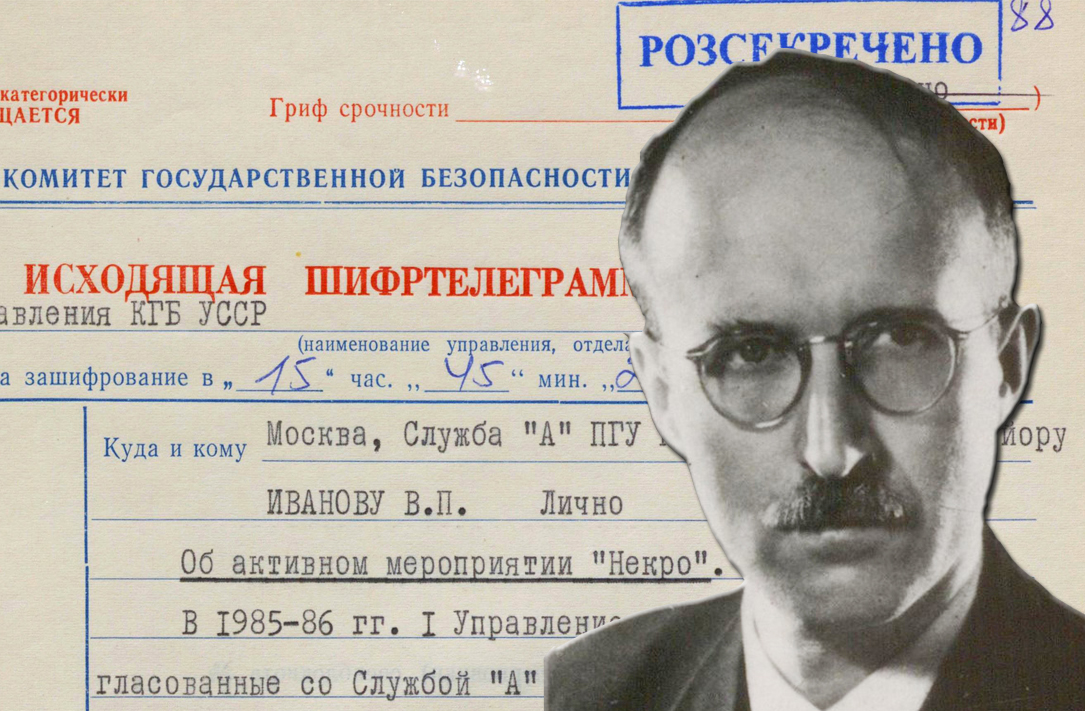
Yaroslav Stetsko, the leader of the OUN(b) Provid (leadership-transl.), permanent President of the Anti-Bolshevik Bloc of Nations(ABN), one of the main ideologues of the Ukrainian national liberation movement and organizer of the struggle for Ukraine's independence, died on July 5, 1986 in Munich. His death was a result of sharp deterioration of his health which was caused by chronic diseases from his time in Hitler's concentration camp, but at the same time — by a special operation of the USSR KGB. Such conclusions are suggested by declassified documents from the archives of the Foreign Intelligence Service of Ukraine, which are still unknown to the general public.
Yaroslav Stetsko was noticed by Soviet special services in the interwar period. At that time, he was mentioned in documents only among other OUN figures. A separate case against him was opened by the Fourth Directorate of the KGB of the USSR (foreign intelligence) on October 21, 1944.
He is described in the case as a “professional steadfast nationalist fanatic” who held positions of the highest importance in the OUN's Regional Provid in Western Ukraine, was persecuted by the Polish authorities for his active work, and was forced to leave for Germany. After the split of the OUN, he entered the leadership of the Bandera wing. It is noted that on June 30, 1941, in the occupied Lviv, he proclaimed the Act of Restoration of the Ukrainian State and headed the Ukrainian government, which was soon disbanded by Germans. Yaroslav Stetsko himself and his supporters were sent to a concentration camp.
In terms of intelligence and operational measures, the task was set to “thoroughly find out Stetsko’s fate”. Having studied primary materials, the authorities put him on the all-Union wanted list. There is the following record of this in the archives: “Wanted by the All-Union State Security Service of the USSR in 1949” according to the “List Number One of Dangerous Criminals Subject to Detection and Immediate Arrest”. The search case had been conducted against him by the 2nd Main Directorate of the State Security Service of the USSR since June 26, 1948.
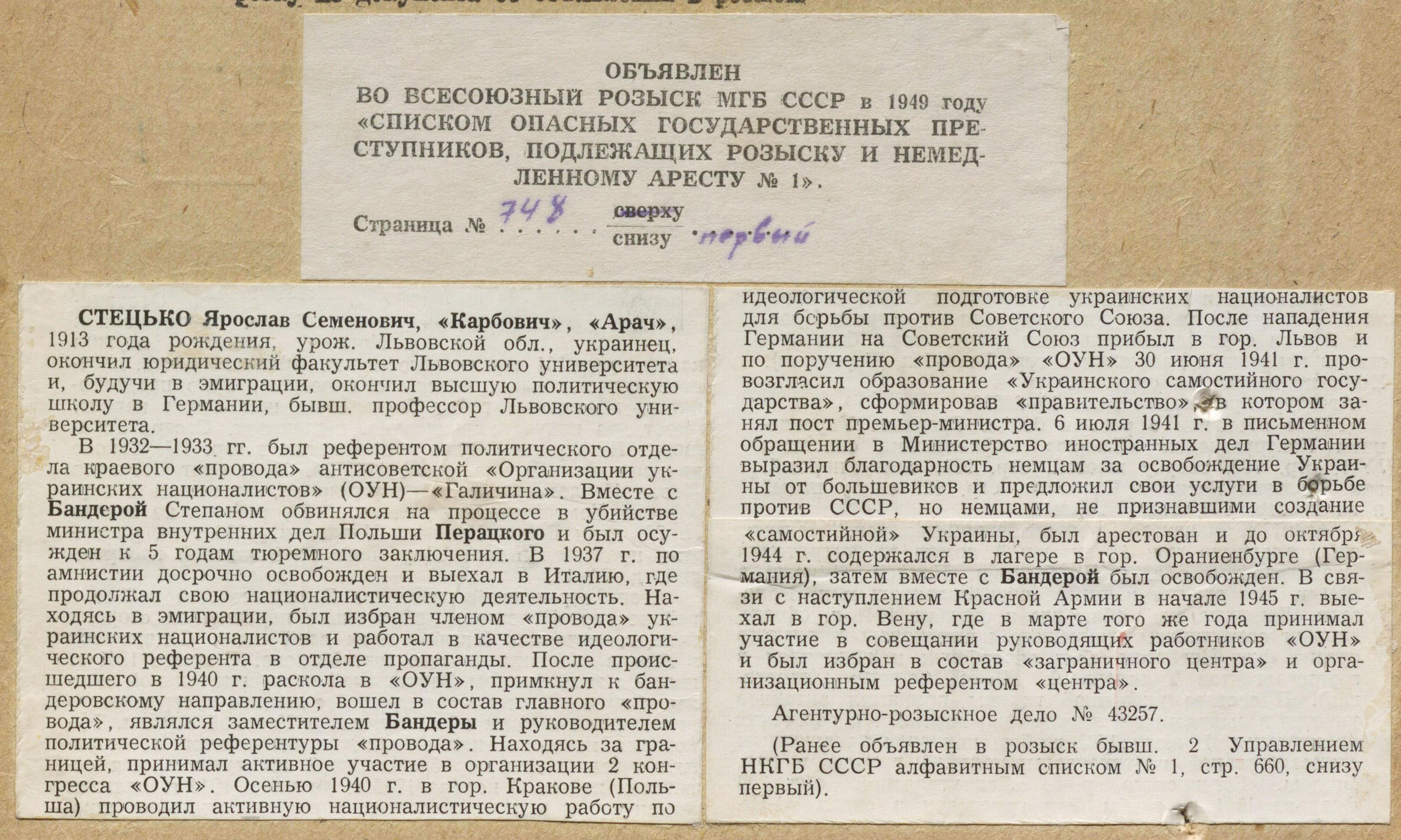
A corresponding arrest warrant was issued, approved by the Deputy Minister of State Security of the USSR and the Military Prosecutor of the troops of the Ministry of Internal Affairs of the USSR on June 30, 1948. At the same time, instructions were given to interrogate Ukrainian nationalists in Soviet camps to obtain information about Ya. Stetsko’s life and work, as well as about his close relatives.
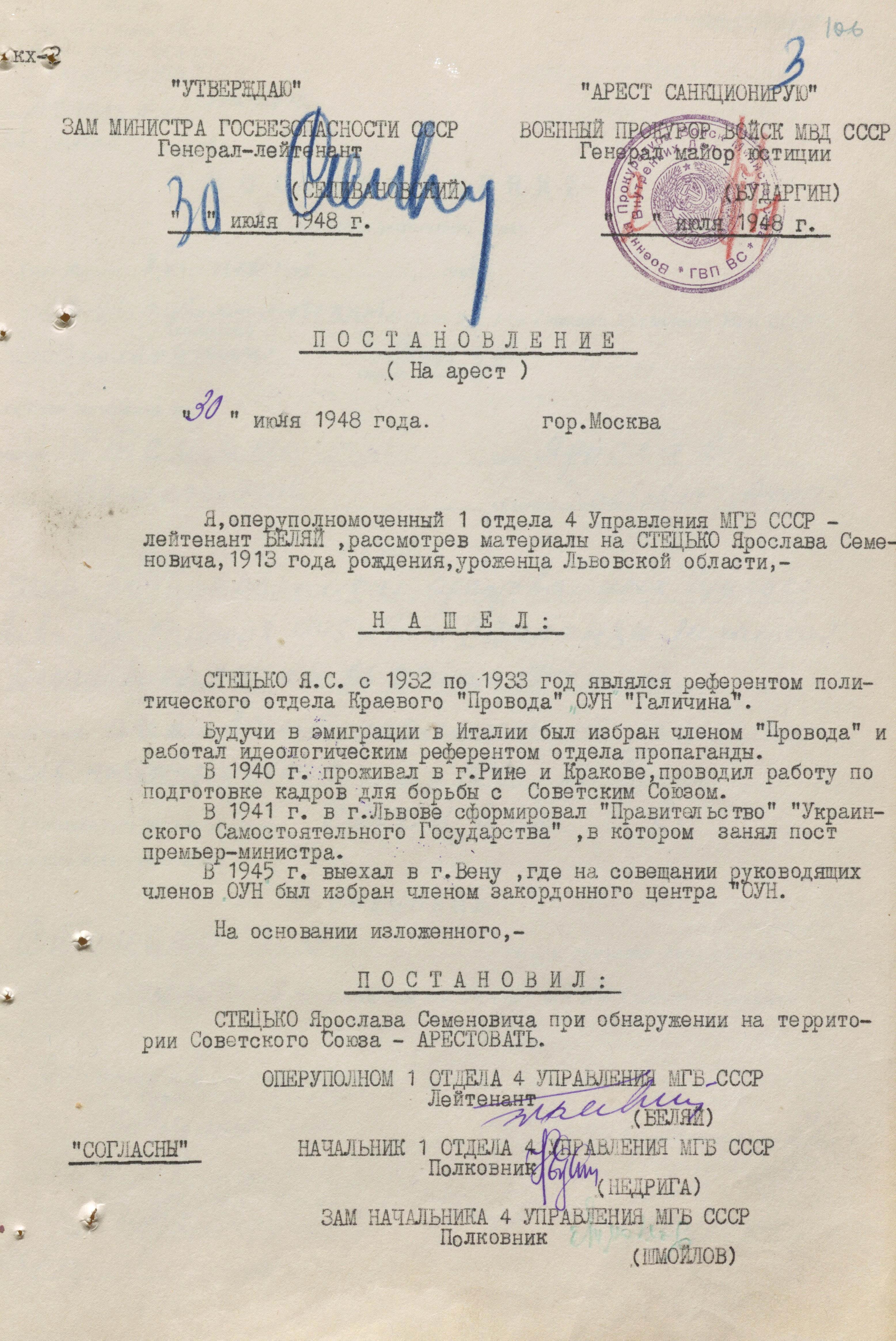
The MGB officers quickly managed to obtain photos of J. Stetsko, which were taken in his youth. Apparently, they were somehow taken from the case under which Ya. Stetsko was sentenced by a Polish court to five years in prison for underground activities. Those photos, among others, were shown to the arrested OUN activists, for them to recognize him.

To Moscow’s request, the Chief of the 1st Directorate of the State Security Service of the Ukrainian SSR (foreign intelligence) replied that they knew Yaroslav Stetsko, he lived in the American zone of occupation of Germany, in Munich. And further in the response it was noted: “Stetsko is on our operational record and is being actively cultivated as one of the leaders of the OUN-Banderites and the “leader” of the so-called “Anti-Bolshevik Bloc of Nations” (BSA of the SZR of Ukraine. - F. 1. - Case 13091. - Vol. 1. - P. 145). That is, at the moment when the central intelligence apparatus in Moscow was opening the case, the operational cultivation of Ya. Stetsko by the officers of the State Security Service of the Ukrainian SSR was well underway. In the future, the relevant measures were carried out simultaneously from the positions of both Moscow and Kyiv, taking into account the available operational capabilities.
The search case against Ya. Stetsko was run for nine years and only in 1957 the KGB leadership under the Council of Ministers of the USSR approved the conclusion: “The all-Union search for Ya. Stetsko to be stopped, the search case # 2641 to be added to the case-file # 152 as its second volume” (BSA of the SZR of Ukraine. - F. 1. - Case 13091. - V. 3. - P. 10).
Every year new materials were added to the case. They tell about Ya. Stetsko’s election to the OUN governing bodies, his organizational work to establish the Anti-Bolshevik Bloc of Nations and his being elected the President of this international representative organization, the signing of an agreement on cooperation with the Chinese Anti-Communist League and the establishment of the mission of the ABN, and his active participation in creation in Tokyo of the “World Anti-Communist League”, creation of the European Freedom Council, which elected him a life member of the honorary presidium, as well as other non-governmental organizations.
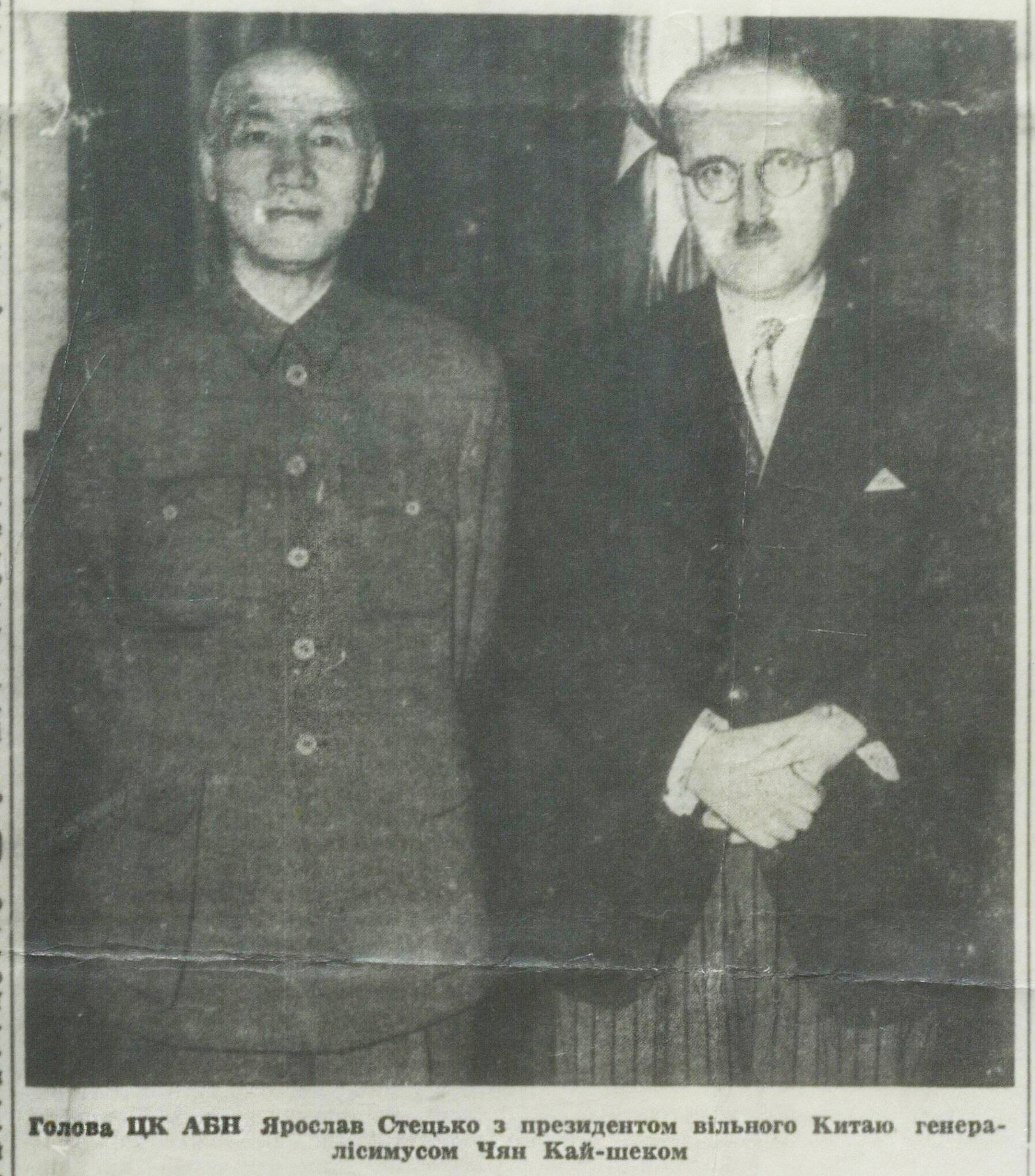
Among the documents about Ya. Stetsko’s activity in the international arena, of special interest are the materials about his participation in the meeting of the US Congressional Committee on Foreign Affairs at the end of July 1958, where he testified. The subject of the hearings, as noted with reference to the publication in the newspaper “Shlyakh Peremohy” ("Way of Victory”- transl.), was “Moscow's Aggression in the Middle East and the Policy of Liberation of Nations Oppressed by Moscow”. Instead of the 30 minutes normally allowed for testimony, Ya. Stetsko was given the opportunity to speak and answer questions for two hours, which showed the great interest of the commission members in the prepared materials. He did not ignore the Ukrainian issue at the meeting. That is why the publication states that “the members of the commission finally expressed their solidarity with Stetsko's statements and supported the idea of Ukraine's independence”.
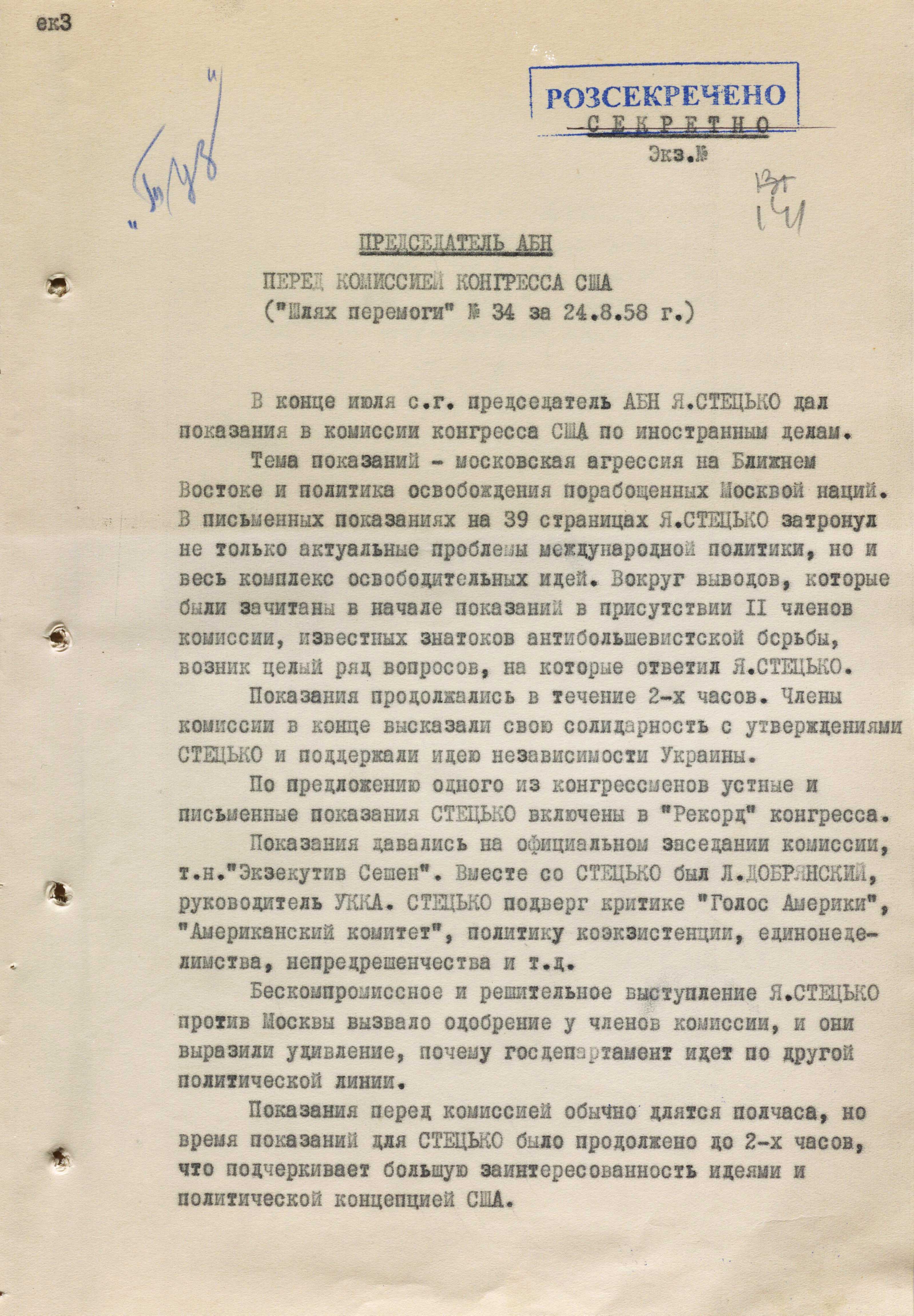
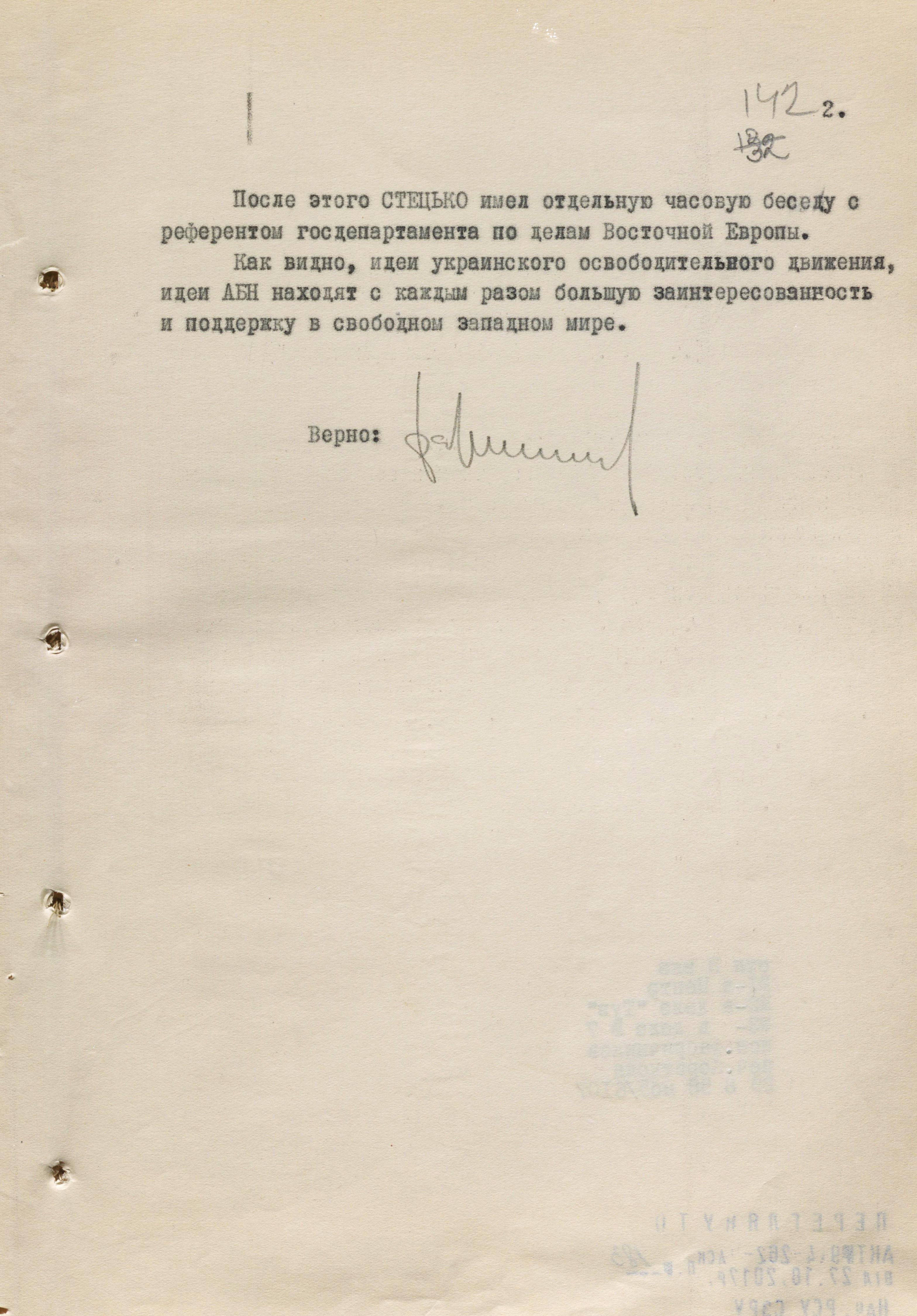
Such activity could not help drawing the KGB’s attention. In order to penetrate Ya. Stetsko's close circle, a number of agents were selected and carefully prepared for work abroad and legends were created for them. Thus, in the first year of operational cultivation by the Directorate of the State Security Committee of the Ukrainian SSR in Lviv region, the “Letyuchyi” agent was prepared for work in Munich.
The plan of using him and sending abroad reads: “ In order to get closer and gain the trust of a member of the Central “OUN Provid” Yaroslav Stetsko, a combination of “Letyuchyi”’s marrying Yaroslav Stetsko’s cousin – Olha Stetsko has been implemented.
In view of the above, “Letyuchyi” should be given the task “with the help of Olha Stetsko to get acquainted, get closer and gain the trust of a member of the Central “OUN Provid” Yaroslav Stetsko in order to soon, with the help of the latter, enter the circle of the Central “Provid” for their cultivation” (BSA of the SZR of Ukraine. - F. 1. - Case 13091. - V. 1. - P. 69).

These plans were partially implemented. According to archival documents, “Letyuchyi”, by order of intelligence officers, got acquainted with Ya. Stetsko’s cousin and married her. The combination of his leaving for abroad was also successful. But it was not possible to get closer to Ya. Stetsko and penetrate the OUN Central Provid.
Other plans were not implemented either, as confirmed by some information in the documents. The operative, who was working with the agent, states in one of the papers: “… After a detailed discussion of these measures, I asked “Letyuchyi ” whether he could perform a more difficult task. The latter, without hesitation, replied: “I understand what you mean, and if necessary, I am always ready to do it on the first order” (BSA of the SZR of Ukraine. - F. 1. - Case 13091. - Vol. 1. – P. 71).
In 1951, plans were made for sending abroad action agents “Yuzhnyi” and “Shumnyi” with the task of operative cultivation of Ya. Stetsko. The documents about them state that they “speak Polish fluently and German quite well, have considerable experience in cultivation of the OUN underground in western regions of Ukraine, in which they have shown themselves as capable, strong-willed agents, loyal to our authorities” (BSA of the SZR of Ukraine. - F. 1. - Case 13091. - V. 1. - P. 186–188).
At the first stage, they were planned to be taken through the eastern part of Berlin to Western Germany without revelation of each other. They had to find out Ya. Stetsko’s place of residence and some other issues and to return. At the second stage, they were supposed together, or as part of an intelligence- combat group, to take Ya. Stetsko back to Western Germany for further cultivation. The legends and methods of communication were worked out with the agents, they were given a code for correspondence, addresses, they learnt Ya. Stetsko’s biography and were shown his photos. The same training and instruction was soon given to the action agent “Zaporozhets”. But there is no information in the archival documents as to whether the goal was achieved.

The case of Bohdan Stashynskyi- the murderer of Lev Rebet and Stepan Bandera, also mentions that he was tasked by his curators to find out Ya. Stetsko's place of residence in Munich, his habits, daily routine, and so on. At the same time, according to B. Stashynskyi himself, he had never received KGB’s approval for the murder.
Despite this, the KGB developed other plans aimed at compromising Ya. Stetsko, undermining his authority, and sowing discord among his supporters. One of the decisions of the Chief of the KGB of the Ukrainian SSR Vitaliy Fedorchuk reads: “Given the activity and extremism of Ya. Stetsko in his activities against the USSR, in order to undermine his authority in the Banderites’ environment, the State Security Committee in 1976-1977 fabricated and distributed “addresses” and leaflets calling for the removal of Ya. Stetsko from the OUN leadership. In this regard, a number of other intelligence and operational measures are being prepared”.
Other measures were intended to incite hostility between Ukrainian nationalists and Zionists. To this end, on the instructions of the KGB, a pamphlet was published in the United States “So That We Would Not Forget”, in which they tried to prove the alleged involvement of OUN representatives in so-called anti-Jewish actions during World War II.
To develop this theme, in 1981 the First Directorate of the KGB of the Ukrainian SSR developed “Measures for Further Deepening of the Contradictions in the SKVU (World Congress of Free Ukrainians - note) and inciting hostility between Banderites and Melnykites”. One of the points of those measures was “on behalf of the supporters of the Zionist “Jewish Defence League” to issue and, in agreement with the Service “A” of the First Main Directorate of the USSR KGB, distribute abroad a leaflet calling for the physical massacre of Stetsko”.
Another paragraph reads: “Because of the possibility of the USSR KGB Mission to the GDR State Security Service on behalf of the “ well-wisher” to organize an anonymous phone call to the editorial office of the Bandera newspaper “Shlyakh Peremohy” with warning Ya. Stetsko to refrain from traveling to Canada in early July this year (to participate in the “celebrations” on the occasion of the 40th anniversary of the so-called “restoration of Ukrainian statehood” and in the Sabbath of the “World Conference of Ukrainian Youth”), as his opponents are preparing his assassination on his way there” (BSA of the SZR of Ukraine. - F. 1. - Case 13091. - V. 5. - P. 48–49).
Another point of the measures was to fabricate and distribute abroad a special issue of the Banderites’ newspaper “Shlyakh Peremohy” with an obituary on the death of Ya. Stetsko. This item was soon finalized, and it resulted in a separate KGB special operation of great importance/

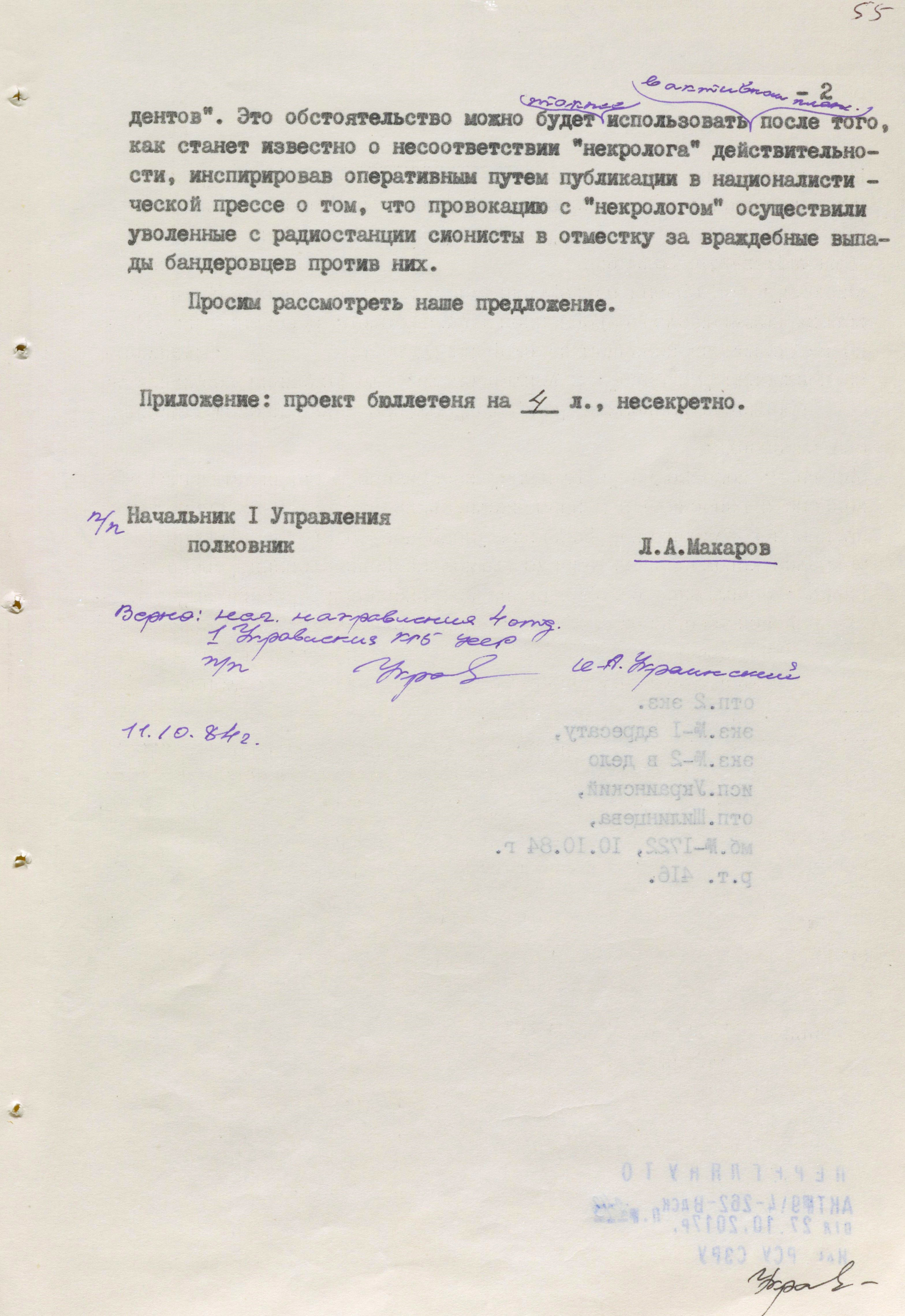
Among the archival documents there is a report “On Special Measures Against the Leader of the ABN and the OUN abroad Ya. Stetsko”, signed by the Chief of the KGB of the Ukrainian SSR Stepan Mukha and addressed to the Head of the Central Committee of the Communist Party of Ukraine Volodymyr Shcherbytskyi. On the first page there is a handwritten inscription: “The information was reported to the Politburo of the Central Committee of the Communist Party of Ukraine by Comrade Mukha S.N. on 9th July 1986”, i.e. four days after Ya. Stetsko’s death.
The report reads:
“In agreement with the USSR KGB, an obituary was broadcast on the radio on April 15, 1986 on behalf of the Ukrainian Radio Liberty in relation to Stetsko, which was also published by some Melnykites’ press. According to the received operative data, the obituary caused a severe nervous shock to Stetsko and, according to his immediate environment, in particular the church authorities Kowalski and Korneliuk, this led to a serious illness.
To exacerbate the controversy over the premature obituary in the nationalist community, the State Security Committee took additional measures to bring to the attention of Stetsko's environment, as well as a number of his opponents, including the staunch anti-Semite apostate V. Moroz, that the obituary was made by a group of Jews working at the Svoboda radio station, with whom the Banderites were constantly at enmity.
The information spread in Stetsko's environment exacerbated the psychological shock he had previously suffered and complicated his illness. According to the operative data obtained at the end of June 1986, Stetsko's health has deteriorated sharply and he is dying”(BSA of the SZR of Ukraine. - F. 1. – Case 13091. - Vol. 5. – P. 110-111).
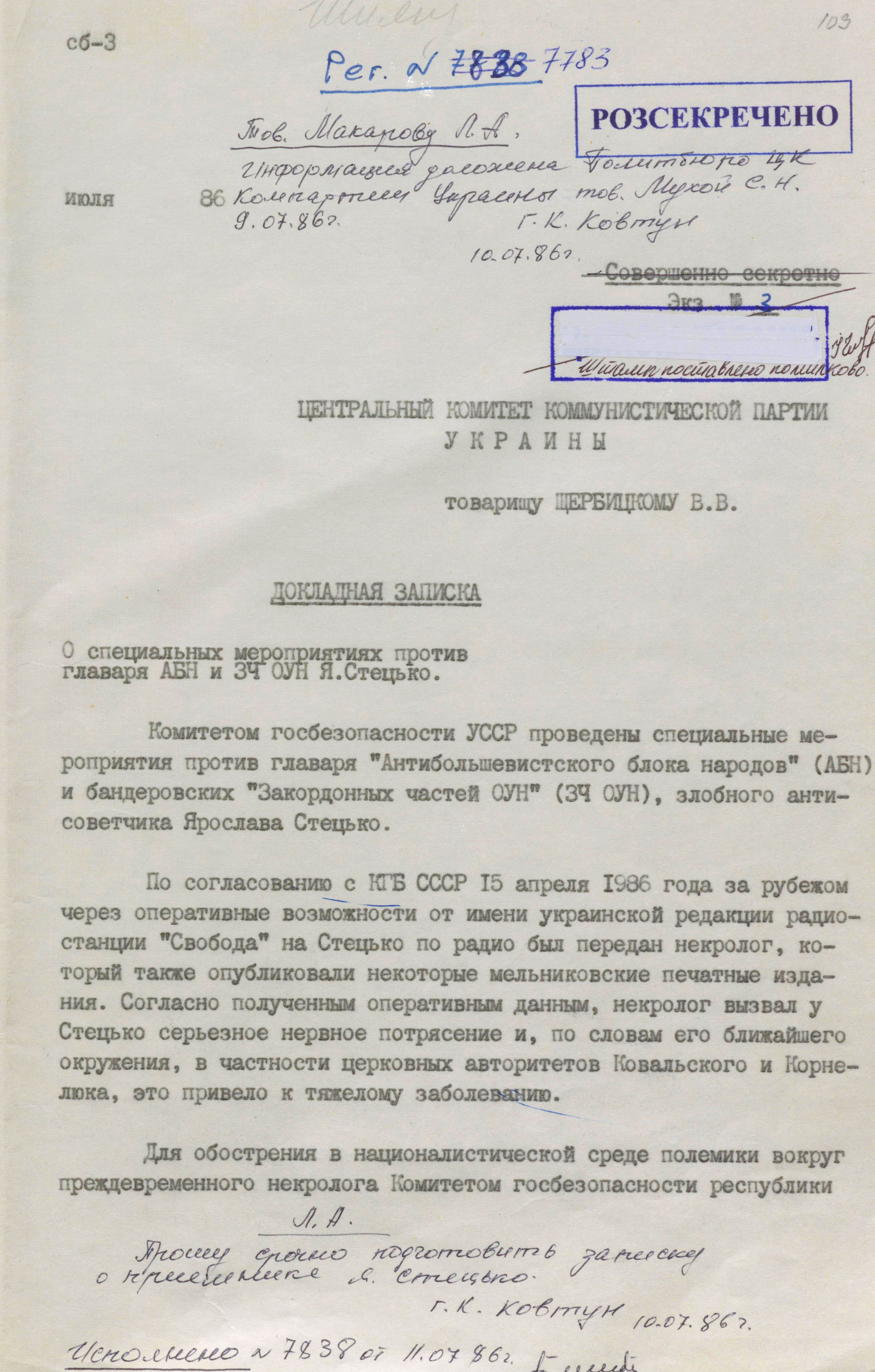
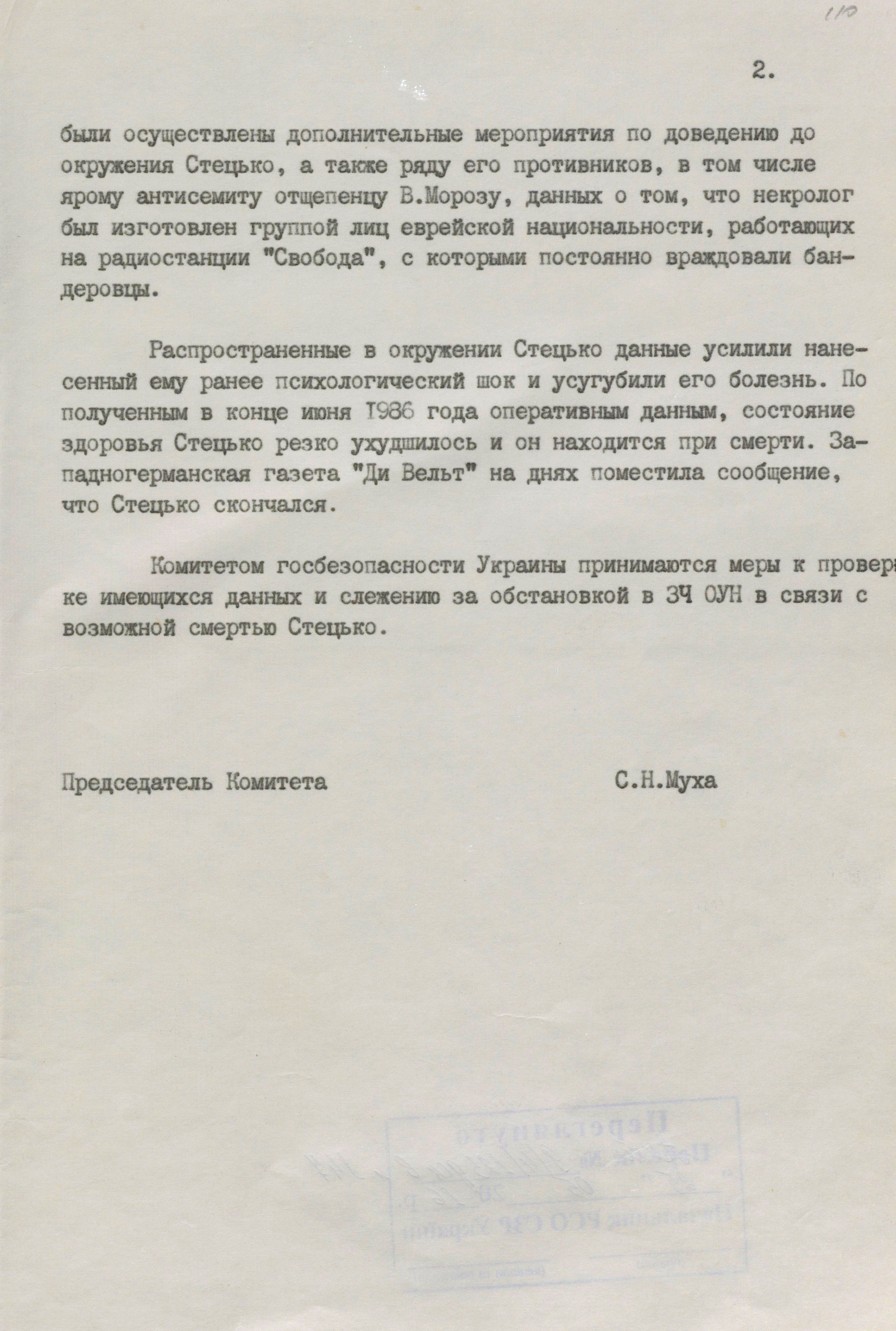
Among the archival materials there is one of the versions of the fabricated by the KGB obituary about Ya. Stetsko’s alleged death. It was made on the form of Radio Liberty and dated March 2, 1985, i.e. a year before the final phase of the special operation under the code name “Nekro”.
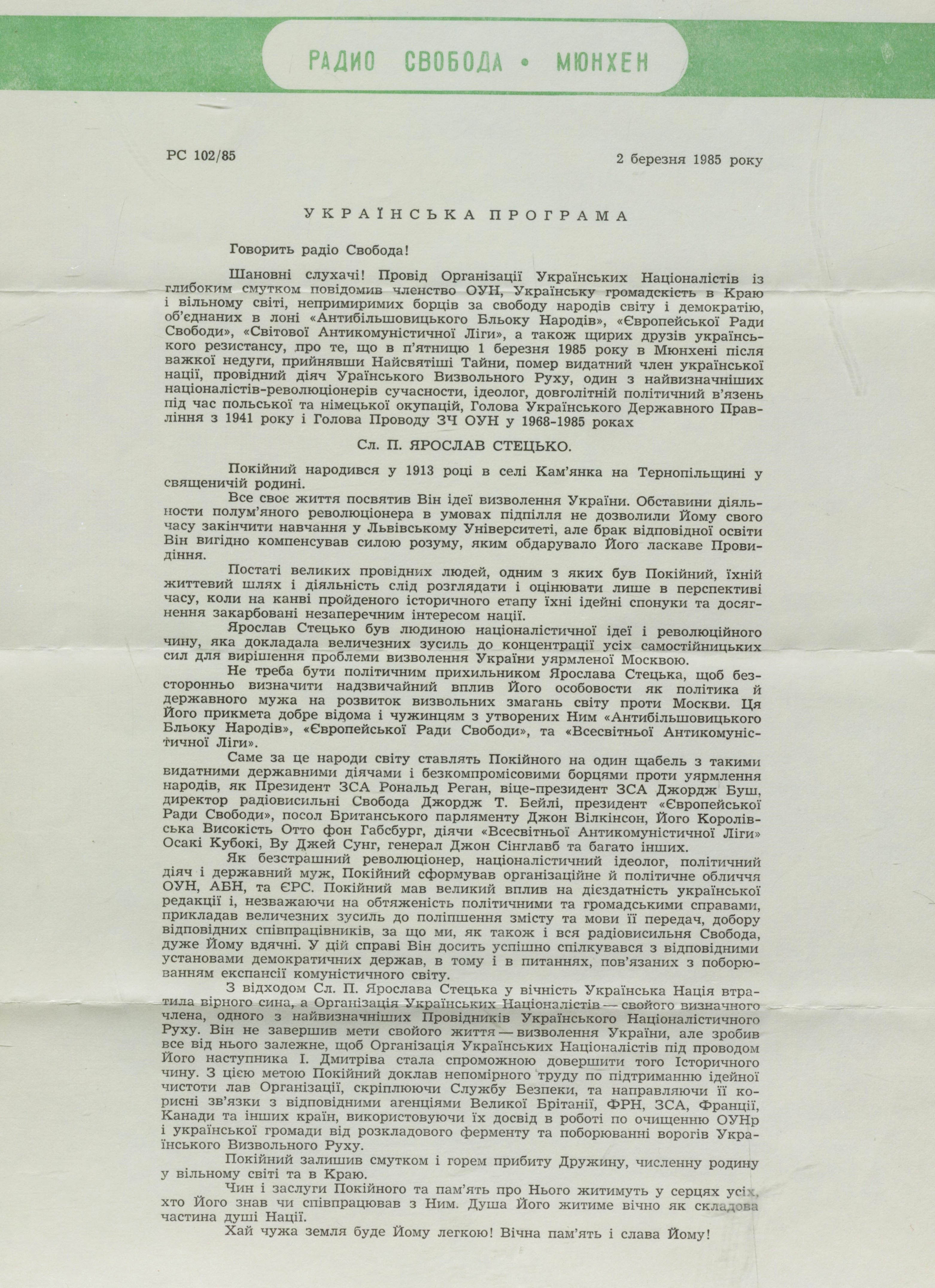
The obituary was the last straw in the series of various KGB’s activities and operations. It undermined the patient's health completely and lead to his death. Such conclusions are contained in the KGB’s document itself.

These documents are important grounds for domestic scholars and historians to look at past events in a new way from the standpoint of the present and to add hitherto unknown episodes to the biography of the outstanding personality in the history of Ukrainian statehood Yaroslav Stetsko, and the reasons for his death.
